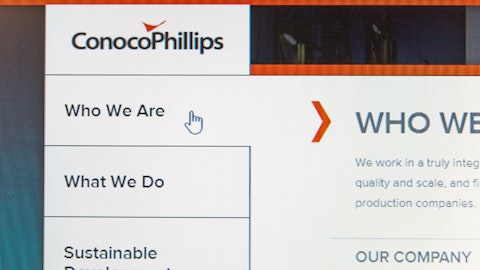ConocoPhillips (NYSE:COP) is one of the biggest oil producers in the world and the newest case study regarding the dangers of chasing yield (the stock had a dividend yield of 3.03% as of yesterday evening).

Among the investors tracked by Insider Monkey, 44 held shares of COP at the end of September 2015, amassing 2.10% of the company’s outstanding stock, which compares with 43 funds holding shares a quarter earlier. First Eagle Investment Management is the largest shareholder of the company among the funds in the Insider Monkey database, holding 7.55 million shares, according to its last 13F filing.
Even worse, income investors that chased COP are sitting on another 2% capital loss this morning as the stock has traded off on the news (COP is down 18% YTD). Chasing yield is a dangerous game, and dividend investors need to remember that we are still playing a total return game where income and price matter. To avoid riskier dividend stocks, income investors might be interested in reviewing our earlier article reviewing how to find safer dividend stocks.Despite its $45 billion market cap, $2.4 billion in cash on hand, and single-A credit rating, COP slashed its quarterly dividend from $0.74 per share to $0.25 per share, representing a 66% reduction. The stock’s yield just fell from 7.7% to 2.6% (using yesterday’s closing stock price of $38.63 per share), and a theoretical $10,000 investment in COP will see its annual income generation drop from about $770 to $260.
Fortunately, we did not own COP in any of our dividend portfolios because it had one of the lowest Dividend Safety Scores in our database with a score of 17 (scores of 50 are average, 75 0r higher is excellent, and 25 or lower is risky). To better understand the safety of a dividend payment, we believe prudent investors must look at a handful of key metrics, including a company’s payout ratios, free cash flow generation, cyclicality, and balance sheet.
As a commodity company, COP required extra scrutiny. Commodity companies are notoriously capital-intensive, often carry high debt loads to fund their operations, generate less predictable free cash flow, and have little to no control over the selling price of their products.
If these businesses overextend themselves during peak operating conditions (e.g. taking on debt to fund major growth projects, acquire a competitor, or repurchase), they can be in for a world of pain when their markets inevitably but unexpectedly cycle down. The timing is almost never good.
With the oil market, this is exactly what happened. OPEC (Organization of the Petroleum Exporting Countries), the largest and lowest-cost group of oil producers, decided to flood the market with supply to take market share back from higher-cost North American shale oil producers. Tepid demand and a flood of incremental supply is a recipe for disaster in any commodity market and oil has been no exception, falling over 70% from its 2014 peak.
No one knows when oil prices will recover or the price they will recover to. However, higher cost producers with extended balance sheets and less diversified businesses are feeling the noose tighten around their necks.
Why did COP have to cut its dividend? Let’s take a closer look at the company’s financials.
Through the first nine months of 2015, ConocoPhillips (NYSE:COP) generated approximately $6 billion in operating cash flow. The company’s capital expenditures totaled $7.9 billion over this period, resulting in a free cash flow drain of about $1.9 billion. COP also paid out about $2.7 billion in dividends during this period. Once dividends are added in, COP’s cash flow drain reaches $4.6 billion through the first nine months of 2015.





